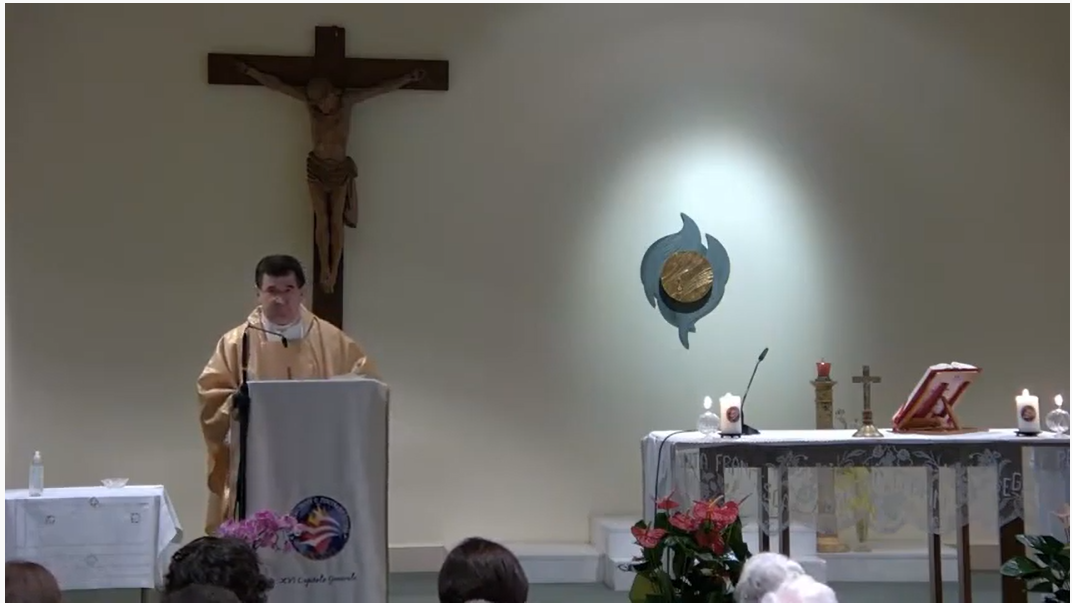The Word of God that we heard on the feast of St. Mary Magdalene is like a light that helps us project the work that you have just concluded in the General Chapter but also in our life of faith. The apostles except John, come the time almost as a figure of what Mary of Magdala experienced in the first reading, as we heard the First Reading from the Song of Songs, this woman who seeks the love of her soul and seeks it and does not find it however at some point she finds it; the love of her soul, this trusting and we can say even inconsolable love of Mary of Magdala for the death of her master leads her to go to the tomb in the morning when it was still dark and seeing that the stone had been removed from the tomb, she runs to announce to John and Peter that they have taken the Lord away. If we follow the whole account of St. John’s Gospel we know that the two disciples rushed to the tomb, John arrived first but then Peter came and entered the tomb and it says the Gospel when John enters the tomb he saw and believed then the two disciples go home and if we read St. Luke’s account two of them disappointed said we hoped it was the master they go to Emmaus, they take the opposite path of Jerusalem. Jerusalem is the place of salvation and after accompanying the master for three years they make the return journey, they go back to their former life, disappointed. Instead Mary, as one would say in Spanish sin embargo, for this inconsolable love of hers-this inconsolable love of his-would not allow him to abandon his search for Jesus. Peter and John see, they believe but they go home, they do not see the master she stays there and says the Gospel she stays there weeping, weeping; a few years ago as you remember Pope Francis in one of his reflections says the world today, we would need the grace of tears, those tears of Mary to mourn the absence of the Lord in the world and it is precisely this attitude of Mary, the darkness, having followed the master that now the tomb is empty but she is in the darkness and she tries to look at the tomb and there she sees the angels announcing to her that the Lord is no longer there; she had seen the master die and even though she saw him die she continued her search, a search in weeping, in the absence of God – weeping is one of the reactions and without this weeping many times as Pope Francis says that weeping, tears are the new glasses of faith; tears allow us to see the Risen One and in fact she re-encounters, meets again with the risen Lord and recognizes him when he calls her by name: Mary! This re-encountering with the Lord, recognizing Him transforms her weeping and brings her back to the joy of going to the disciples and announcing to them what she had seen, making her the first witness of the Resurrection and the first messenger announcing the Lord’s Resurrection, makes her the apostle of the apostles as St. Thomas Aquinas called her, the apostle of the apostles. Dearest Cabrinian sisters, in Mary Magdalene’s relationship of faithful love with the Lord, with the Risen Lord, we can identify three elements that are present in Mary Magdalene’s life and in Mother Cabrini’s life and that we are also invited to take up again in our lives today.
The first is to see Jesus again, to see Jesus crucified laid down in the darkness in which he finds himself, in so many brothers and sisters who live in situations of lack of dignity, of exclusion, of poverty, to see Jesus again and like Mary and like Mother Cabrini to let ourselves be moved by him and to let ourselves be seen again by him and this is an attitude we know that in the conjugation of verbs there is the active mode and there is also the passive mode – to see Jesus again but to let ourselves be seen again by Jesus poor, excluded, emigrated, abandoned, to look him in the eyes.
The second to recognize him because Mary of Mary Magdalene also saw Jesus she saw him in the garden but she confused him with the gardener; it is not enough to see him again it is to recognize him and recognizing him requires a personal relationship with him of hearing ourselves named by him.
Mary when she said to him, “Woman what are you looking for?” she did not recognize him when he says to her, “Mary!” she recognized him and many are the situations in which the presence of the risen Lord in the world is relived, like Mary Magdalene we recognize him when we are personally involved, when we hear ourselves called by name. In the previous chapter the Lord had called Sister Barbara Staley to lead the congregation and today he calls Maria Eliane Azevedo da Silva and he calls Sister Gilda Mendoza, Sister Patrizia Godoy and Sister Stella Maris Elena to support Maria Eliane; he calls each one of you by first and last name as he called Mother Cabrini by first and last name; today the Lord is calling you and entrusting you with the mission as general leadership but also as capitulars to animate the presence of the Risen Lord throughout the world, to help your Cabrinian family to make the Risen Lord recognized, following the footsteps of Mother Cabrini.
The third aspect is what identifies you as Missionaries of the Sacred Heart is to remember the Lord in order to be able to proclaim Him, to see Jesus again, to recognize Him risen in us and in the world and to remember Him, to bring Him back to our hearts and let us be remembered by Him, to constantly bring the risen Lord back to our hearts and to remember that He remembers us, He brings us back to His heart. As Missionaries of the Sacred Heart of Jesus you are invited to remind the world that the Risen Lord is still present and that He remembers us and brings us back to His heart; in keeping with the phrase of St. Frances Cabrini that you have chosen to guide the work of your general chapter “Untie, melt and put on your wings” to see again and let yourselves be seen again, to recognize and let yourselves be recognized and to remember and let yourselves be remembered by Jesus of the Risen Lord; precisely in this perspective of remembering, bring back to the heart as a Scalabrinian missionary, we want as a Scalabrinian family to bring back to the heart Cabrinian and Scalabrinian family, to bring back to the heart Mother Cabrini’s collaboration with our Blessed Founder who will shortly be proclaimed a Saint, we want to recall their collaboration in the face of the urgent needs of the migrants who met, they met and saw, they saw, they recognized and they committed themselves in the face of the situations of need of the migrants at the end of the nineteenth century and through their works, through their personal commitment and also with the institutions they established, they promoted evangelization and articulated social action to uproot the darkness of the tomb they were in using the image of Mary seeking Jesus and weeping because Jesus is in the tomb, they saw, they were moved, they wept but they were committed to a response and even today we are invited to renew this collaboration, our commitment to work together to soothe the material and spiritual wounds of so many brothers and sisters who are forced to live far from their homeland, to uphold their rights, to keep their Christian faith alive, and to raise the international community’s awareness of open and supportive welcome. Here then may the Lord sustain you and sustain us in our mission to bring him to the world, to remind the world that he is in many situations in the darkness of lack of recognition but is found risen. “Untie and put on your wings” is an invitation in this very perspective when Pope Francis recognizes St. Mary Magdalene as a feast to remind the Church of the specific role of women in the Church even today, as Mary Magdalene was the first witness and proclaimer of the risen Lord Mother Cabrini also paved the way in a context where generally missionary work was linked to male institutes; she was like Mary Magdalene, a pioneer of the role of women in the Church and this prophetic presence of Cabrini, you carry it forward today, you carry it forward and in the Church we carry it forward together. Cabrini felt that the Lord called her Francesca as a missionary but together with Francesca the Lord called John Baptist Scalabrini, called the bishop of New York of the time with the conflicts of the time – even today there will always be conflicts. Pope Francis says the only community where there are no conflicts is the cemetery, there are no conflicts there. Living communities have conflicts, the important thing is that the conflict doesn’t end in the tension of remaining me on my side and the other on the other side, tensions will always exist we have to go beyond conflicts to communion in diversity of visions, diversity of charisms, diversity of vision, diversity of congregations in the Church but all called by the Lord to build communion in diversity.
May St. Frances Cabrini continue to enlighten your commitment and may her invitation to loosen the chains of the many times of indifference or the difficulties you find in the face of closed mindsets, may the Lord give you the strength to continue to carry out her prophetic presence in the Church and in the world. So be it.

